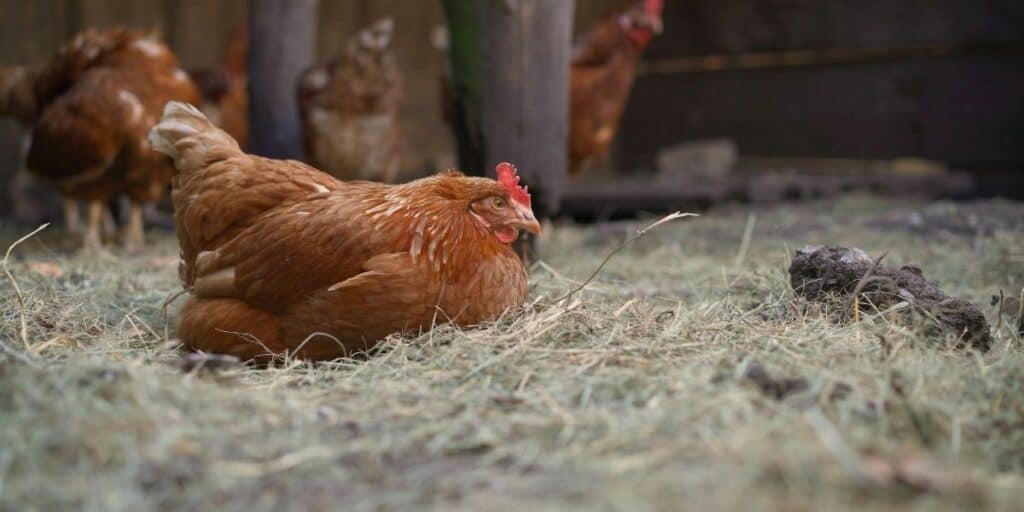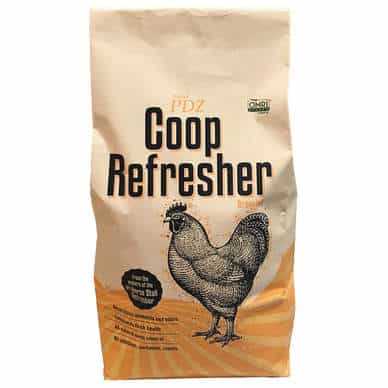Bedding is an absolute priority for keeping your hens clean, fresh, and disease-free.
It may be a no-brainer for some, but selecting the right bedding can make all the difference in quite literally keeping your chickens well.
Overlook it and your backyard flock can run into serious problems very quickly!
There are lots of options for reliable bedding materials that will do the hard work of absorbing the ‘by-products’ of your chickens day to day activity and keeping the coop sanitary.
This concise but comprehensive article will run through the key bedding options available and provide you with great picks for reliable poultry bedding that keeps caring for your hens as simple as it should be!
Table of Contents
Firstly, what is poultry bedding?
Bedding or litter is the material that you use on the floor of your hen house to absorb their waste, keeping the birds clean, dry, and preventing the build-up of ammonia harmful bacteria, fungi, and mold in their indoor environment.
Why do I need a bedding material for my hens?
Skipping bedding, the use of a poorly performing litter material, or leaving bedding in place for a prolonged period without changing it cause major disease for hens and impact their well-being and quality of life.
- Spores from rotting and moldy bedding can cause aspergillosis, a progressive respiratory condition that kills.
- Parasitic diseases like coccidiosis can be transmitted via infected bedding.
- Excess dust and ammonia is an irritant of a hens respiratory system which can become inflamed with difficulty in breathing.
- Highly concentrated ammonia levels can also injure the eyes of your chickens by causing conjunctivitis.
- Manure contaminated bedding and nest material can also transmit Salmonella.
If there is an outbreak of disease amongst the hens, failure to promptly change beddings will cause disease spread amongst the birds, so keeping on top of bedding changes is a good habit to get into.

What are the options for bedding for a chicken coop?
Thankfully there are plenty of options for effective bedding materials that will do a great job of keeping your hens as fluffy as they should be.
Most types are readily available and cost-effective when used correctly. Let’s run through the key types of poultry bedding:
- Softwood shavings are dust extracted, soft and absorbent and make a soft and insulating bedding when layered within your coop. Wood sources like pine and cedar have additional antiseptic properties. Take care by introducing these to chicks as they may mistake the shavings for food! We have used Manna Pro pine bedding for some time now. Available here on Amazon
- Shredded paper seems like a good idea and is great if you have nothing to hand, but it compacts very quickly so you need lots of it and frequent changes to keep things fresh. We recommend if you’re going to use shredded paper you use unbleached bedding like this one on Amazon
- Shredded cardboard is absorbent and less likely to compact than paper, making it a good bedding option. It also can be composted after use.
- Straw is a cheap and easy material but is not as absorbent as wood shavings. It tends to compact and break down quickly, necessitating frequent changes. Do not mix up straw with hay. Hay is not suitable for poultry bedding as it quickly produces mold and fungal spores that can cause respiratory problems. We like EZ-Straw from Amazon
- Aubiose is a hemp-derived fibrous material that makes highly absorbent and dust-free bedding. It lasts a long time and even repels flies, making it a great all-round litter material.
- Wood pulp animal bedding uses a by-product of the papermaking industry to produce a long-lasting and absorbent bedding material that is easy to clean too.
- Grass and leaves are also an option but it’s important to ensure that they haven’t been sprayed with pesticides that could harm your hens. They can also rot quickly so frequent changes will be required.
- Sand may seem strange but is actually effective and re-usable bedding. A generous layer of sand will keep poop, ammonia, and bacteria at bay for a long time, and is comfortable underfoot for the birds. It is a particularly good option for winter where the hens may be in the coop more. The best type is builders sand which can also be used as grit.
Can I use sawdust for my hen house bedding?
Sawdust, as its name indicates, is extremely dusty and should be avoided as a bedding material.
It can cause respiratory problems for both you and your hens.
Wood shavings are dust extracted and have a larger particle size.
Fine sawdust and also sands like play sand can be eaten by younger birds, causing impaction.
Are there any substances that I can add to poultry bedding to improve its performance?
There are a number of substances you can add to your poultry bedding to boost its absorbance, control odor, and keep harmful microorganisms at bay.
- Essential oils like oregano and tea tree oil can be sprinkled on bedding for deodorizing and antimicrobial benefits.
- Herbs like lemon balm, sage, bay leaves, and dried basil can be scattered among your layers of bedding to aid odor and for their antimicrobial properties.
Why not try Organic Nesting Herbs by Happy Hen Treats?
These USDA-certified organic nesting herbs by Happy Hen Treats are ideal for a healthy and comfortable coop environment.
This special blend of peppermint, pot marigold (calendula), thyme, rosemary, chamomile, raspberry leaf, nettle, red clover, and lavender is simply spooned on your coop floor and nesting and bedding material. It comes in a 230h (4 ounces) pack.
- Bokashi active bran uses a special Japanese fermentation technique to introduce a beneficial microbial balance to your litter. This ingenious and all-natural additive helps safely break down the harmful substances in the bedding for odor control. The hens can also eat this treated bran as it improves their gut bacteria.
- Zeolite minerals are an absorbent powder that not only deodorizes but also extends the life of your bedding. It keeps down ammonia and other harmful gases. This formulation should be sprinkled on the bedding at a concentration of 25 grams per square meter.
Give this a go by using Sweet PDZ Coop refresher!

This zeolite mineral is great for zapping urine and ammonia while keeping odor under control.
Applying a light coating of this non-toxic powder to your coop every few days extends the life of your bedding and it is safe to compost when you are ready to clear out.
Alternatively, the Manna Pro Coop ‘N Compost is a similar mineral-based powder that safely deodorizes your coop.
What’s the deep litter method?
The deep litter approach to poultry bedding involved the spreading of sequential layers of clean animal bedding on top of previously soiled bedding, rather than cleaning and changing the bedding each time.
New layers are added every two to four weeks, depending on the size of your coop.
When done properly, feces and moisture are absorbed and broken down while the hens are using a surface of clean material.

How often should I change poultry bedding?
This all depends on what you and your hens are prepared to tolerate.
Some backyard poultry keepers can let bedding run for a month or so without a change, whereas others make providing fresh bedding an unfailing weekly duty.
Frequent changes provide your hens with good sanitation and prevent the stress and suffering of disease.
The number of hens and the size of your coop will aid decisions in this area.
Winter also places additional demands, so a clear out every one to two weeks is a good habit to get into.
What are the signs that my chickens’ bedding needs to be changed?
- Matted damp bedding.
- Raised moisture levels in the coop.
- Ammonia odor.
- Presence of active disease or parasites.
Rounding up
Getting bedding for your hens right is part of providing them with the good care that they need to stay healthy and thrive.
While you settle into your bedding routine it’s well worth experimenting with the different types of bedding to find out which one will work for you and your hens.
Always keep plenty on hand.
Most forms of poultry bedding are vacuum-packed for easy storage and should be kept in a clean dry place.
Other Types of Bedding










